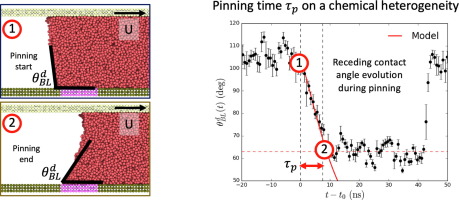当前位置:
X-MOL 学术
›
J. Colloid Interface Sci.
›
论文详情
Our official English website, www.x-mol.net, welcomes your
feedback! (Note: you will need to create a separate account there.)
Controlling the pinning time of a receding contact line under forced wetting conditions.
Journal of Colloid and Interface Science ( IF 9.4 ) Pub Date : 2020-01-20 , DOI: 10.1016/j.jcis.2020.01.054 J-C Fernández-Toledano 1 , C Rigaut 1 , M Mastrangeli 2 , J De Coninck 1
Journal of Colloid and Interface Science ( IF 9.4 ) Pub Date : 2020-01-20 , DOI: 10.1016/j.jcis.2020.01.054 J-C Fernández-Toledano 1 , C Rigaut 1 , M Mastrangeli 2 , J De Coninck 1
Affiliation

|
HYPOTHESIS
The contact line pinning that appears in a flow coating process over substrates patterned with chemical or physical heterogeneities has been recently applied to deposit micro- and nanoparticles with great precision. However, the mechanism underlying pinning of a receding contact line at the nanoscale is not yet well understood. In the case of a contact line pinned at a chemical heterogeneity, we hypothesise that it is possible to establish a relation between the pinning time, the contact line velocity and the liquid/plate/heterogeneity affinity that can help to optimize particle deposition.
METHODS
We use large-scale molecular dynamic (MD) simulations of a finite liquid bridge formed between two parallel, non-identical, smooth solid plates. The top plate slides relative to the bottom plate inducing a displacement of the four different contact lines of the liquid bridge. The introduction of a chemical heterogeneity on the bottom plate by modifying locally the liquid-solid affinity provokes the transient pinning of the contact line in contact with the bottom substrate. By means of this simple MD simulation, we can study the mechanism of contact line pinning and its relation with the liquid/heterogeneity affinity and the contact line velocity. Additionally, we compare this mechanism with the case of the receding contact line pinned on a physical heterogeneity (a simple step discontinuity).
FINDINGS
We propose an analytical model that predicts the values of the dynamic contact angles in the general case of a capillary liquid bridge confined between two parallel plates with different wettabilities versus the relative velocity of the top plate. These predictions are successfully validated by the results of the large-scale MD simulations. The model allows thus to predict the value of the dynamic contact angles for the different contact lines of the system versus the relative speed of the moving plate. Once the chemical heterogeneity is introduced in the bottom plate, we show that when the receding contact line reaches the patch it remains temporarily pinned while the receding contact angle evolves with time. Once the receding angle reaches the value of the equilibrium contact angle of the patch, the receding contact line overcomes pinning. A geometrical model able to predict the pinning time is proposed and validated by our MD simulations. The pinning time depends not only on the relative plate velocity and plate wettability properties but also on the separation distance between the plates confining the capillary bridge. The model can consequently be used to select the substrate wettability or meniscus geometry suitable to impose the pinning time required for specific applications.
中文翻译:

在强制润湿条件下控制后退接触线的钉扎时间。
假设近来,在流涂工艺中出现在化学或物理异质性图案化的基材上的接触线钉扎技术已被用于高精度地沉积微粒和纳米颗粒。然而,尚不十分了解在纳米级后退接触线钉扎的机理。在接触线固定在化学异质性的情况下,我们假设可以在固定时间,接触线速度和液体/板/异质亲和力之间建立关系,以帮助优化粒子沉积。方法我们使用在两个平行的,不同的,光滑的固体板之间形成的有限液桥的大规模分子动力学(MD)模拟。顶板相对于底板滑动,从而引起液桥的四个不同接触线的位移。通过局部改变液-固亲和力而在底板上引入化学异质性会引起与底基板接触的接触线的瞬时钉扎。通过此简单的MD模拟,我们可以研究接触线钉扎的机理及其与液体/非均质亲和力和接触线速度的关系。此外,我们将此机制与固定在物理异质性上的后退接触线(简单的步骤间断)的情况进行了比较。研究结果我们提出了一个分析模型,该模型可以预测在通常情况下,在两个具有不同润湿性的平行板之间的毛细管液桥相对于顶板相对速度的动态接触角值。这些预测已通过大规模MD模拟的结果成功验证。该模型因此允许预测系统的不同接触线的动态接触角的值与移动板的相对速度的关系。一旦将化学异质性引入底板,我们就会证明,当后退接触线到达贴片时,它会暂时保持钉扎状态,而后退接触角会随时间变化。一旦后退角达到贴片的平衡接触角的值,后退的接触线克服了钉扎现象。提出了一种能够预测钉扎时间的几何模型,并通过我们的MD仿真进行了验证。钉扎时间不仅取决于相对板速度和板可湿性,而且还取决于限制毛细管桥的板之间的分离距离。因此,该模型可用于选择适合于施加特定应用所需钉扎时间的基材润湿性或弯月面几何形状。
更新日期:2020-01-21
中文翻译:

在强制润湿条件下控制后退接触线的钉扎时间。
假设近来,在流涂工艺中出现在化学或物理异质性图案化的基材上的接触线钉扎技术已被用于高精度地沉积微粒和纳米颗粒。然而,尚不十分了解在纳米级后退接触线钉扎的机理。在接触线固定在化学异质性的情况下,我们假设可以在固定时间,接触线速度和液体/板/异质亲和力之间建立关系,以帮助优化粒子沉积。方法我们使用在两个平行的,不同的,光滑的固体板之间形成的有限液桥的大规模分子动力学(MD)模拟。顶板相对于底板滑动,从而引起液桥的四个不同接触线的位移。通过局部改变液-固亲和力而在底板上引入化学异质性会引起与底基板接触的接触线的瞬时钉扎。通过此简单的MD模拟,我们可以研究接触线钉扎的机理及其与液体/非均质亲和力和接触线速度的关系。此外,我们将此机制与固定在物理异质性上的后退接触线(简单的步骤间断)的情况进行了比较。研究结果我们提出了一个分析模型,该模型可以预测在通常情况下,在两个具有不同润湿性的平行板之间的毛细管液桥相对于顶板相对速度的动态接触角值。这些预测已通过大规模MD模拟的结果成功验证。该模型因此允许预测系统的不同接触线的动态接触角的值与移动板的相对速度的关系。一旦将化学异质性引入底板,我们就会证明,当后退接触线到达贴片时,它会暂时保持钉扎状态,而后退接触角会随时间变化。一旦后退角达到贴片的平衡接触角的值,后退的接触线克服了钉扎现象。提出了一种能够预测钉扎时间的几何模型,并通过我们的MD仿真进行了验证。钉扎时间不仅取决于相对板速度和板可湿性,而且还取决于限制毛细管桥的板之间的分离距离。因此,该模型可用于选择适合于施加特定应用所需钉扎时间的基材润湿性或弯月面几何形状。











































 京公网安备 11010802027423号
京公网安备 11010802027423号